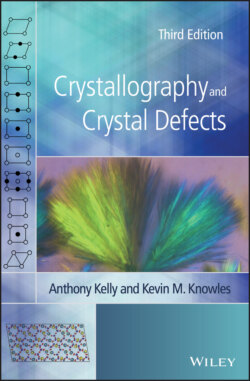Читать книгу Crystallography and Crystal Defects - Anthony Kelly - Страница 28
Notes
Оглавление1 1 1 Å = 10−10 m.
2 2 In choosing a unit parallelogram or a unit cell, the crystal is always considered to be infinitely large. The pattern in Figure 1.1a must then be thought of as extending to infinity. The fact that O, X, A and Y in a finite crystal are at slightly different positions with respect to the boundary of the pattern can then be neglected.
3 3 Indices for planes are termed Miller indices after William Hallowes Miller (1801−1880) who popularized the use of these indices through his book A Treatise on Crystallography published in 1839 [1]. Interestingly, Miller was not the first to advocate the use of the (hkl) notation for planes – as Miller himself acknowledged in a preface to his book, the Rev. William Whewell had previously noted that planes can be represented by indices h, k and l in this manner in 1825 [2].
4 4 Formally, the law of rational indices states that all planes which can occur as faces of crystals have intercepts on the axes which, when expressed as multiples of certain unit lengths along the axes (themselves proportional to a, b, c), have ratios that are small rational numbers. A rational number can always be written as p/q, where p and q are integers.
5 5 The name Weiss zone law for this equation was first used by William James Lewis (1847−1926) in the form Weiss's zone‐law on pages 39 and 40 of his 1899 book on crystallography [3]. Lewis's reasoning was that Christian Samuel Weiss (1780−1856) had been the first to call attention to this relationship through his 1804−1806 translation into German of René Just Haüy's 1801 Traité de Minéralogie. Miller knew about this equation as well – it is derived geometrically on page 10 of [1].
6 6 A discussion of whether these should be termed symmetry operators or symmetry elements, the term used in previous editions of this book, is given in Section 1.2.3 of [4]. Current International Union of Crystallography nomenclature is to use the term symmetry operators, reserving the word ‘element’ to define a member of a set, such as a group (Section 2.14). Readers should be aware that both terms are used in practice in the crystallographic literature.
7 7 The volume a · [b × c] is equal to abc sin α cos ϕ, where ϕ is the angle between a and the normal to the plane containing b and c. See also Equation (1.42). If a ≤ b ≤ c and α, β and γ are all <90°, the primitive unit cell described in this manner is a positive reduced form or Type I cell in the nomenclature of Santoro and Mighell [5]; if a ≤ b ≤ c and α, β and γ are all ≥90°, the primitive unit cell is a negative reduced form or Type II cell in the same nomenclature. Both these forms are examples of unit cells termed reduced cells or Niggli reduced cells after Paul Niggli's original work on this topic [6].
8 8 The attention of the reader is, however, drawn to Section 4.6.1 for a discussion on the contemporary definition of crystals in the light of the discovery of quasicrystals and other materials in which there is ordering in an aperiodic manner.
9 9 Of course, this does not preclude local rotation axes having unusual rotation symmetries, for example the occurrence of local icosahedral coordination found in compounds such as MoAl12 and in individual C60 molecules in buckminsterfullerene (Section 4.5). However, when these units pack together in crystals, the fivefold rotational axes of the individual units are lost when describing the symmetry of the crystal.
10 10 Depending on how the motif showing fourfold symmetry is arranged with respect to the two axes of the crystal – the sides of the square in Figure 1.14b – additional symmetry elements may arise. A full discussion of this point for any of the arrangements of symmetry elements in Figure 1.14 – that is, a discussion of consistent arrangements of symmetry elements in space – would take us immediately into the subject of space groups. We defer this until much later (see Section 2.12), but the discerning reader may wish to glance at Section 2.12 before proceeding further, both to gain reassurance that this subject matter is understood and to appreciate the mass of detail which is avoided by not following up this question now. The question of how additional symmetry elements may arise is considered in Problem 1.14.
11 11 This conforms to the notation used by Buerger [7].
12 12 These are termed Bravais lattices after Auguste Bravais (1811–1863). Eight years before Bravais wrote about the space filling of lattices, Moritz Ludwig Frankenheim (1801–1869) published his book System der Krystalle in which he also considered the same problem [13]. Frankenheim believed he had identified 15 arrangements. However, two of these in the monoclinic system (C and I) were shown by Bravais in a footnote on page 97 of his 1850 article to be equivalent [14]. This equivalence is shown in Figure 1.22. As a consequence of Bravais showing that the monoclinic C and I lattices are identical, these space lattices are known as Bravais lattices, rather than Frankenheim lattices.
13 13 The validity of this statement does not follow immediately at this point. Its truth is plausible if it is noted, as shown later (Section 2.1), that an inverse diad axis plus a centre of symmetry is equivalent to a diad axis normal to a mirror plane, and that the lattice points of a lattice are centres of symmetry of the lattice.
14 14 A means a lattice point on the (100) face, B a lattice point on (010), and C a lattice point on (001), in all crystal systems.
